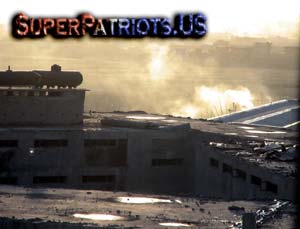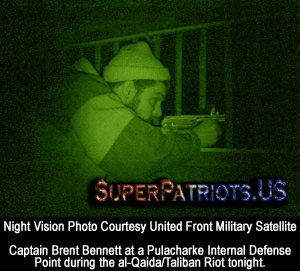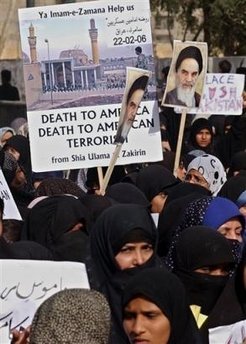
It’s been one hell of a week for Jack Idema, Brent Bennett and Ed Caraballo, the three Americans illegally imprisoned in Afghanistan.
For the benefit of those who haven’t been following events since last Saturday, Pulacharke, the prison Jack, Brent and Ed are being held at, is now effectively under the control of Taliban and al-Qaeda prisoners. Jack and Brent are holed up in their Block 2 Annex, armed, and protected by members of the Northern Alliance. Ed Caraballo, who was being held in another section of the prison, has been taken hostage by the Taliban, who have threatened to decapitate him if their demands are not met. Other hostages include 50-or-so female prisoners from the womens’
block, who the Taliban have now been gang-raping for the last four days.
So, yes, this is a mess … Though you wouldn’t think that if you were getting your news from MSM, most of whom have slavishly (and, it must be said, lazily) repeated President Karzai’s ‘official’ line without question. Here’s the BBC, yesterday, appearing to believe the riots were winding down nicely:
‘Breakthrough’ in Kabul jail riot
Rioting inmates in Afghanistan’s main prison near Kabul have agreed to hand over their dead and injured, amid signs of a
breakthrough in the stand-off.
[…]
One of the chief negotiators said he would be taking the prisoners’ demands to the government and that he was hopeful of a peaceful solution.
Gunfire was heard within the prison walls on Saturday night and Sunday, but the BBC’s Bilal Sarwary in Kabul says the situation was calmer on Monday, with only two gun shots heard, and fewer troops at the scene.
This, of course, came after a terrible night in which female prisoners could be heard screaming such things as::
“Oh Merciful God,” one women screamed repeatedly. Others could be heard screaming in Dari and Pashto, “they are f***ing me, God help me.” “Allah take me, let me die….” “Stop, stop, kill me, kill me first.”
The only reference you’ll find on the BBC to these sickening events is the following, throwaway line:
Senior jail officials say they fear some of the women inmates may have been raped.
Untrue. Jail officials know, for certain, that women are being raped — As would the BBC, leastways if their reporter had been anywhere near Pulacharke during the last few days. Instead, the typical MSM position seems, as usual, to be one of soft-peddling any information that might impact negatively on the activities of their beloved ‘insurgents’.
This also seems to be the attitude of the U.S. State Department and the Karzai government, who’ve spent the week obstructing any and all efforts to use force against the terrorists in order to seize back control of Pulacharke. Here’s just a selection, from the SuperPatriots, of what they’ve been up to since the riots broke out:
~ The National Army has been ordered by Karzai not to fire on his “Taliban brothers.”
~ US Embassy refuses air support and troops to stop terrorist takeover.
~ Apparently, Karzai and the US State Department have interfered with the military response to the revolt.[…]At 1am last night, we said that the MOJ refused to let Jack lead a force in against the terrorists. Although the NA Generals refused to allow Jack and his men to be put a risk, they decided to assault the terrorists with batons followed by a wave of armed troops. THREE AMERICAN advisors sent by the US State Department and Department of Justice were now present, they ORDERED the NA Generals NOT TO ATTACK. The “American Advisors,” who probably know as much about Afghanistan as a car salesman in Wisconsin, were placed in control by Hamid Karzai.
~ General Salem-Bashi, one of Massoud’s best generals, along with Northern Alliance Generals Samad and Zorodin are now on site. They planned to again attack BLOCK 2 and put down the revolt. AGAIN, the US State Department and now the Red Cross decided they knew more than the Northern Alliance generals about how to deal with terrorists. The State Department, US Justice Department, and Red Cross “Advisors” called “the palace” and successfully stopped the assault.
~ A Karzai spokesman gives a television statement that the women are now safe and in government control. According to our intelligence, this is a complete lie. The women are still held hostage and being raped by the terrorists.
~ Karzai officials again give press statements that the women are safe and not in terrorist hands. The reality is far different, the women are disbursed as hostages and are being repeatedly raped by the terrorists.
~ Karzai officials are saying that things are fine and they are “considering the demands” of the terrorists. US Department of Justice and State Department “advisors” quickly left the prison earlier today when their plan to negotiate backfired and MOJ lost another two prison blocks to the enemy.
~ Karzai and the US Embassy ordered the MOJ police not to attack yesterday morning, and to negotiate. Now the result is what could be the largest gang rape in the world’s modern history.
~ Karzai calls the Governor of Kabul and attempts to send in National Police to seize Jack’s phones. Apparently, after unknown foreign journalists complained that Jack was releasing information from inside the prison revolt, and had access to phones and intelligence and photos, Karzai demanded Jack’s communications be shut down. Were journalists upset that Jack and this website were contradicting their fabricated stories of the revolt?
~ Karzai’s peace envoy showed up at Pulacharke with five cars of bodyguards. “Minister Mujahedi” promptly outlined Karzai’s plan: give full amnesty to all terrorists and Taliban murderers, surrender the 80 women hostages, get new beds, new clothes, and new digs. No one will be charged with murder, rape, assault, revolt, or any other crime. As if it wasn’t enough, Mujahedi’s speech to the terrorists included telling them, “The men that died here, they died as martyrs.” Mujahedi also ordered officials in the MOJ to continue release false casualty counts, and say that only four or five people had been killed and only thirty wounded, instead of the real numbers which are far higher.
Clearly, something is going terribly wrong with the Afghan end of the WoT. Here we have a situation in which hundreds of the world’s most dangerous and committed terrorists have seized dozens of hostages, including a U.S. citizen. Yet the response from both President Karzai and the U.S. State Department has been to downplay the violence committed by Taliban and al-Queda prisoners, and then to openly negotiate with them. Think about that. Wasn’t the U.S. position after 9/11 supposed to be one of never negotiating with the monsters who brought the twin towers down? Yet, here we are, doing just that, and in response to ‘men’ who are threatening the life of a U.S. citizen in between gang-rapes of female hostages. How on earth did it come to this?
And how, as we learn from al-Reuters, did the following situation arise?:
Mawlavi Mohammad Siddiqi, a cleric who was one of those held by Idema’s vigilante group and is now acting as a mediator in the prison standoff, told reporters Idema was not in danger, but Caraballo was “not in a good place”.
Siddiqi, we will remember, was arrested by Jack Idema while in possession of the following items:
~ Photographs of Sidiq with Gulbuddin Hekmatyar
~ Bomb plans
~ Explosive detonators
~ al-Qaida and Hezb-i-Islami documents and recruiting cards
~ A letter from Taliban leader Mullah Omar
Ironies don’t get any more bitter than this one: that a creature like Siddiqi should be reinvented by the U.S. and Afghan governments as a ‘mediator’, while the brave and decent soldier who arrested him fights for his life in Pulacharke prison, first dismissed as a ‘vigilante’, then ignored by the whole, credulous, MSM. Unbelievable.

.
So what can we do? Well, anyone reading this with their own blog can sign up for the weekly Free Jack Idema Blogburst by emailing Cao or Rottweiler Puppy for details. I’d urge everyone to do this, as we’re still terribly short on takers. If you want to know more about the story, Cao’s Blog has a large section devoted to Jack Idema. There’s also a timeline here, and, of course, a huge amount of information is available over at SuperPatriots, without whose work none of us would have learned about Jack’s story.
Finally, PLEASE NOTE:
The SuperPatriots and Jack images on this site are used with WRITTEN COPYRIGHT PERMISSION and any use by any third party is subject to legal action
by SuperPatriots.US
jack idema
afghanistan
Technorati Search
for Jack Idema
The Free Jack Idema Blogroll:
The Pink Flamingo Bar & Grill
The Lone Voice
Red Hot Cuppa Politics
Kender’s Musings
Irate Nate
The Devil’s Kitchen
Cao’s Blog
Big Dog’s Weblog
Theodore’s World
NIF
Rottweiler Puppy
Making
Headlines
My Newz n’ Ideas
Right For Scotland
Freedom Folks
The City Troll


* Cao’s Blog
* Rottweiler Puppy
 Wild Thing’s comment……
Wild Thing’s comment……
 Wild Thing’s comment…….
Wild Thing’s comment…….









 Wild Thing’s comment…..
Wild Thing’s comment…..
Recent Comments